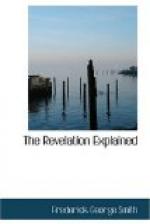7. And one of the four
beasts gave unto the seven angels seven
golden vials full of the wrath
of God, who liveth for ever and
ever.
8. And the temple was filled with smoke from the glory of God, and from his power; and no man was able to enter into the temple, till the seven plagues of the seven angels were fulfilled.
The scene presented to us in this vision is but an introduction to the solemn scenes of awful judgment immediately following. The first thing that attracted John’s attention was a sign, great and marvelous, “seven angels having the seven last plagues.” The reason why these are denominated the “last plagues” is because that “in them is filled up the wrath of God.” These are the completion, then, the finishing up of the work of divine judgment against the persecutors of the church. When the last one is poured out the work is done, the time of judgment is over. These angels are not designed to symbolize any agencies on earth, for they do not appear on earth; they are simply the conductors of the Revelation. God never commissions his people on earth to perform such great judgments upon their persecutors as the temporal judgments of the seven last plagues will be shown to be; but, on the contrary, he has given them the express command not to avenge themselves, but to suffer wrong. He himself lays exclusive claim to this prerogative, saying, “Vengeance is mine; I will repay, saith the Lord.” Rom. 12:19.
As soon as the subject of the plagues is introduced and before they are poured out, the narrative suddenly changes and a short history of God’s redeemed saints is given. This, perhaps, thus occurs for two reasons—to assist us in fixing the chronology of the events described and to encourage us with the thought that, even while the awful judgments of God are being “made manifest” upon the haughty oppressors of earth, God has a chosen people who have “gotten the victory over the beast, and over his image, and over his mark, and over the number of his name.” They stand upon the “sea of glass, having the harps of God”—a symbol of melody and praise—and sing the song of Moses and the song of the Lamb. The song of Moses was that sung by the Israelites when they had escaped to the further side of the Red Sea, thus securing perfect deliverance from their enemies. So, also, this company of worshipers sing a great song of deliverance—deliverance from the beast and his image. In chapters 4 and 5 John saw the great host redeemed before the apostasy standing on this sea of glass, singing the song of redemption—the song of the Lamb—but this company are enabled to sing another song as well—the song of deliverance—for they have “gotten the victory over the beast, and over his image, and over his mark, and over the number of his name.” Halleluiah! “Great and marvelous are thy works, Lord God Almighty; just and true are thy ways, thou King of saints.”




